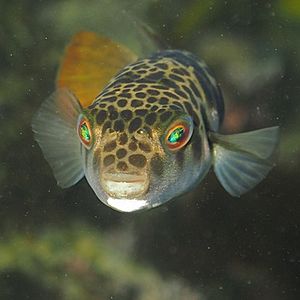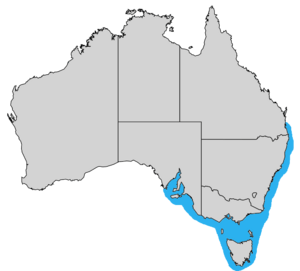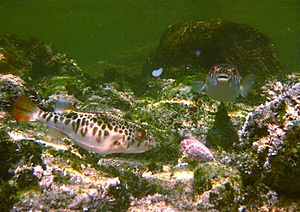Smooth toadfish facts for kids
Quick facts for kids Smooth toadfish |
|
|---|---|
 |
|
| Conservation status | |
| Scientific classification | |
| Genus: |
Tetractenos
|
| Species: |
glaber
|
 |
|
| Smooth toadfish range | |
| Synonyms | |
|
Tetrodon glaber Fréminville, 1813 |
|
The smooth toadfish (Tetractenos glaber) is a type of fish. It belongs to the pufferfish family called Tetraodontidae. You can find it in shallow coastal waters and estuaries (where rivers meet the sea) in southeastern Australia. It is very common there.
A French scientist named Christophe-Paulin de La Poix de Fréminville first described this fish in 1813. For a while, people sometimes mixed it up with its close relative, the common toadfish. These two fish are the only members of their group, called the Tetractenos genus.
The smooth toadfish can grow up to 16 centimeters (about 6 inches) long. It has dark, leopard-like spots on its back. Its front part is rounded, and it gets thinner towards its tail. Unlike many other pufferfish, it doesn't have obvious spines on its body. Like other pufferfish, it can puff itself up with water or air when it feels scared.
This fish looks for its food in the sand and mud at the bottom of the water. It mainly eats molluscs (like snails and clams) and crustaceans (like crabs and shrimp). People who fish often catch the smooth toadfish by mistake. It is very poisonous because of a substance called tetrodotoxin in its body. Eating it can be deadly.
Contents
About the Smooth Toadfish Name
A French scientist named Christophe-Paulin de La Poix de Fréminville first described the smooth toadfish in 1813. He called it Tetrodon glaber. The fish he studied was found in Adventure Bay in southeastern Tasmania.
The name glaber comes from a Latin word meaning "bald" or "smooth." This refers to the fish's smooth skin, which doesn't have obvious spines. For many years, scientists confused the smooth toadfish with the common toadfish. It was hard to tell which fish old records were talking about. This confusion was finally cleared up in 1983.
Over time, the smooth toadfish was given many different scientific names. It was placed in groups like Tetrodon and Sphaeroides. In 1983, a New Zealand scientist named Graham Hardy created a new group, or genus, called Tetractenos. He put both the smooth toadfish and the common toadfish into this new group. This was because they were different enough from other fish to have their own special group.
People call this fish by many common names. These include smooth toadfish, smooth toado, slimey toadfish, or smooth blowie. In Australia, these fish are often just called "toadies." The Tharawal people, who are Indigenous Australians from the Sydney area, have a name for toadfish: Gaguni.
What the Smooth Toadfish Looks Like
Adult smooth toadfish can be anywhere from 3 to 16 centimeters (about 1 to 6 inches) long. Their body is long, with a rounded back and a flat belly. The body gets thinner towards the tail. All of its fins are long and rounded.
The fin on its back, called the dorsal fin, has 9 to 11 rays. The fins on its sides, called pectoral fins, have 15 to 18 rays. The fin on its underside, called the anal fin, has 7 to 9 rays. Its tail fin, or caudal fin, has 11 rays.
The smooth toadfish has a small mouth with thin lips. Its eyes are round and cannot move. Just in front of its eyes are two small, nipple-shaped bumps. These are its nose organs.
The smooth toadfish has tiny spines. These spines are completely hidden inside its skin. They run along its back, sides, and belly. Even when the fish puffs itself up, its skin stays smooth. It can swallow water or air to make itself swell up.
The top part of the fish is light tan to yellow-green. It has many irregular brown spots that look like a net pattern. It also has several wide, dark brown bands. These bands are found between its eyes, between its side fins, and near its back fin. This spotted pattern continues along the sides of the fish. The lower sides are silver-white. Its chin and belly are white. The fins have a light yellow-orange color, especially the tail fin.
Female smooth toadfish are usually larger and heavier than males. These fish keep growing steadily as they get older. One fish that was 16 centimeters long was found to be 13 years old. They start to reproduce when they are about 7 to 8 centimeters long. You can tell the smooth toadfish apart from the common toadfish because it doesn't have spines. Also, its spots are larger and bolder.
Where Smooth Toadfish Live
The smooth toadfish lives along the eastern and southeastern coast of Australia. You can find it from Moreton Bay in southeastern Queensland down to Port Lincoln in South Australia. It also lives near Kangaroo Island and in Tasmania. It is one of the most common fish in the muddy parts of Port Philip Bay.
This fish usually lives in shallow water, less than 3 meters (10 feet) deep. It often stays over mudflats in estuaries. In areas with seagrass beds, smooth toadfish are more often found in the sandy areas next to the seagrass. They prefer seagrass patches in water less than 1.5 meters (5 feet) deep, rather than deeper water.
We don't know much about how far they travel. However, studies show that smooth toadfish spend most of their lives and reproduce in estuaries. They can even go into freshwater, far past the brackish (slightly salty) areas. For example, in 1964, a group of toadfish was found in the Lang Lang River. This was 34 kilometers (21 miles) from Western Port Bay, far from the ocean's tides.
Conservation Status
The smooth toadfish is found over a large area and there are many of them. Their population seems stable. Because of this, the IUCN Red List classifies them as Least Concern. This means they are not currently at risk of disappearing. We don't know how the loss of their homes, like mangroves and seagrass beds, might affect them in the future.
Reproduction and Life Cycle
Scientists have not studied the breeding habits of pufferfish that live in estuaries very much. A study in the Hawkesbury River near Sydney found that smooth toadfish breed between April and July. Before breeding, from February to April, they build up fat in their liver.
What Smooth Toadfish Eat
The smooth toadfish has strong jaws that can easily crush shellfish and crustaceans. It mainly eats organisms that live on the bottom of the water, in the mud or sand. Its diet includes molluscs like black mussels, pipis, and oysters. It also eats crustaceans like semaphore crabs and shrimp. Sometimes, it eats brown algae.
The amount of crustaceans versus molluscs it eats can change a lot. This depends on how much food is available. For example, in one study, soldier crabs were the main food in one creek, while black mussels were the main food in another nearby creek. Experiments showed that the smooth toadfish eats oysters and a type of snail called Bembicium auratum. It has a big impact on how many of these creatures are in an area.
Because it is a common fish in estuaries, scientists have used it to study heavy metal pollution in coastal waters. Studies on fish around Sydney showed that metals built up most in their reproductive organs. Then, they built up in muscles, gills, and liver. The levels of lead, cadmium, and nickel in the fish matched the levels in the mud where the fish lived. This suggests they got these metals from their food.
Toxicity and Safety
The smooth toadfish is known for stealing bait from fishing hooks. It is not a fish that anglers want to catch because its meat is very poisonous. It is not safe for people to eat. Since it doesn't have spines, it's easier to handle than other toadfish if you catch it and it puffs up.
See also
 In Spanish: Tetractenos glaber para niños
In Spanish: Tetractenos glaber para niños




